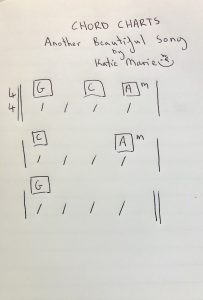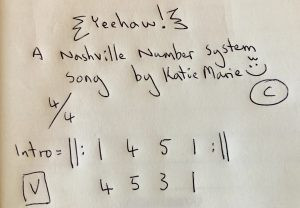Creating music is a rewarding experience, and for guitarists, understanding chords is fundamental. Whether you’re just starting your musical journey or looking for a straightforward way to document your song ideas, Easy Guitar Chords Charts are invaluable. In recording sessions and songwriting, clear and simple charts ensure everyone is on the same page, saving time and fostering creativity. Over years of studio work, I’ve seen firsthand the difference good charts make. While some musicians provide incredibly detailed scores, others offer only basic audio tracks. Regardless, the lesson is clear: well-organized charts lead to smoother, more productive sessions, allowing everyone to focus on making great music.
Getting Started: Understanding Song Structure
Before diving into chart types, grasping basic song structure is key. It’s the roadmap for your music. For simplicity and conciseness in charts, common abbreviations are used. These act as musical shorthand:
- V – Verse
- C or CH – Chorus
- B or BD – Bridge
- Inst – Instrumental
In some regions, like the UK, the Bridge might be referred to as a “Middle 8,” often abbreviated in charts as “M8.” While some might differentiate between a Bridge and a Middle 8 technically, in practical music charting, especially for guitarists, they often serve the same structural purpose within a song.
Exploring Simple Guitar Chord Chart Options
Once you have the song structure outlined, let’s explore various easy guitar chords chart formats. These examples are primarily geared towards guitar and other melodic instruments, but the underlying principles can extend to percussion charting as well.
1. Lyrics with Guitar Chords
 Example of lyrics with guitar chords chart
Example of lyrics with guitar chords chart
This is arguably the most beginner-friendly type of easy guitar chords chart. It’s straightforward: lyrics are written out, and guitar chords are placed above the words where the chord changes occur. Many guitar learners find this format incredibly easy to follow because it directly links the chords to the song’s progression as sung.
The main advantage is its simplicity. You don’t need extensive music theory knowledge to create or read these charts. It’s a fantastic starting point for guitarists learning basic chords and song structures. However, the limitation is that it doesn’t precisely indicate the rhythmic duration of each chord within a measure. For songs with rhythmically complex parts, this can be less informative. Despite this, lyrics with guitar chords are perfect for getting your initial song ideas down and sharing basic chord progressions with other musicians, especially beginners.
2. Basic Guitar Chord Charts with Rhythm Marks
 Example of a basic guitar chord chart with rhythm marks
Example of a basic guitar chord chart with rhythm marks
Building upon the simplicity of lyrics with chords, basic guitar chord charts introduce rhythm markings. This type of easy guitar chords chart provides more rhythmic information without becoming overly complex. Typically, the chart is divided into measures (or bars), reflecting the song’s time signature. In common time (4/4), each bar has four beats.
Looking at the example, you see chords written for each bar. Beneath the chords, rhythm markings indicate how long each chord is played. In the example, under the first bar’s chords (G C Am), you see lines representing beats. Here, G gets two beats, C gets one beat, and Am gets one beat. This rhythmic notation gives guitarists a clearer picture of the strumming pattern or chord duration.
Another common way to notate rhythm is to imply the first chord starts on the first beat. For instance, if you see “G C” in a bar in 4/4 time without further markings, it could imply G gets two beats and C gets two beats. These basic chord charts are a step up in detail from lyrics and chords, offering enough information for many guitar-based songs while remaining easy to read and create, making them ideal for guitarists of varying levels.
3. The Nashville Number System for Guitar
 Example of a Nashville Number System chart
Example of a Nashville Number System chart
For guitarists who want a more versatile and slightly more advanced easy guitar chords chart system, the Nashville Number System is excellent. Its beauty lies in its simplicity and adaptability, especially when working in recording sessions or collaborative songwriting where key changes might be frequent. The Nashville Number System allows you to chart songs based on chord relationships within a key, rather than specific chord names. This means you can easily transpose a song to a different key without rewriting the entire chart.
How it works for guitarists: Instead of writing chord letters like G, C, or D, you use numbers to represent chords within a key. In a major key:
1 = Major chord, 2 = Minor chord, 3 = Minor chord, 4 = Major chord, 5 = Major chord, 6 = Minor chord, 7 = Diminished chord.
Let’s take a song in the key of C Major. The C major scale notes are C-D-E-F-G-A-B. In the Nashville Number System, these scale degrees correspond to chords. So, 1 represents the C major chord, 2 represents D minor, 4 represents F major, 5 represents G major, and so on.
A simple two-bar verse progression in C Major might be written in number form as:
[ 1 1 4 5 ] [ 1 1 2 2 ]
For a guitarist in the key of C, this translates to:
[ C C F G ] [ C C Dm Dm ]
Now, the power of this system reveals itself when you want to change keys. If you decide to play the same progression in G Major, the number chart stays exactly the same:
[ 1 1 4 5 ] [ 1 1 2 2 ]
But now, in the key of G Major, the chords become:
[ G G C D ] [ G G Am Am ]
The Nashville Number System also has its own set of symbols for rhythm and articulation. While these exist, for guitarists, standard rhythm notation can often be clearer. This system, while slightly more abstract initially, becomes incredibly intuitive and efficient once grasped, particularly for guitarists playing in bands or studio settings where flexibility is key.
4. Full Music Score (Less Common for Easy Guitar Charts)
Full music scores are the most detailed form of music notation. They include melody lines, precise rhythms, harmonies, and often articulation markings. While incredibly comprehensive, full scores are less common for creating easy guitar chords charts primarily because they require music reading proficiency, which many guitarists, especially beginners, may not have.
In full scores, every detail is notated note-for-note. While this level of detail is essential in classical music and complex arrangements, it can be overkill for typical guitar-based songwriting or studio sessions, especially when aiming for simplicity and ease of use. However, for guitarists who are fluent in music notation, a full score provides the ultimate level of control and information.
Final Thoughts on Easy Guitar Chord Charts
Creating easy guitar chords charts is about finding the right balance between simplicity and information. For beginners and for quickly jotting down song ideas, lyrics with chords are perfect. For a bit more rhythmic clarity, basic chord charts with rhythm markings are excellent. For flexibility and key changes, the Nashville Number System is a powerful tool. Full scores, while detailed, are less often needed for basic guitar charting.
What’s your experience with charting? Do you have a preferred method for creating easy guitar chords charts? Are there any apps or tools you find particularly helpful for guitarists creating charts? Share your thoughts and recommendations in the comments below!
